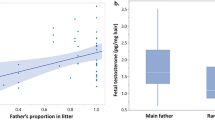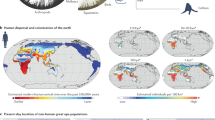Abstract
Crosses between the two North American rodent species Peromyscus polionotus (PO) and Peromyscus maniculatus (BW) yield parent-of-origin effects on both embryonic and placental growth1,2. The two species are approximately the same size, but a female BW crossed with a male PO produces offspring that are smaller than either parent. In the reciprocal cross, the offspring are oversized and typically die before birth. Rare survivors are exclusively female, consistent with Haldane's rule, which states that in instances of hybrid sterility or inviability, the heterogametic sex tends to be more severely affected3. To understand these sex- and parent-of-origin-specific patterns of overgrowth, we analysed reciprocal backcrosses. Our studies reveal that hybrid inviability is partially due to a maternally expressed X-linked PO locus and an imprinted paternally expressed autosomal BW locus. In addition, the hybrids display skewing of X-chromosome inactivation in favour of the expression of the BW X chromosome. The most severe overgrowth is accompanied by widespread relaxation of imprinting of mostly paternally expressed genes. Both genetic and epigenetic mechanisms underlie hybrid inviability in Peromyscus and hence have a role in the establishment and maintenance of reproductive isolation barriers in mammals.
This is a preview of subscription content, access via your institution
Access options
Subscribe to this journal
Receive 12 print issues and online access
$209.00 per year
only $17.42 per issue
Buy this article
- Purchase on Springer Link
- Instant access to full article PDF
Prices may be subject to local taxes which are calculated during checkout





Similar content being viewed by others
References
Dawson, W.D. Fertility and size inheritance in a Peromyscus species cross. Evolution 19, 44–55 (1965).
Rogers, J.F. & Dawson, W.D. Foetal and placental size in a Peromyscus species cross. J. Reprod. Fertil. 21, 255–262 (1970).
Haldane, J.S.B. Sex-ratio and unidirectional sterility in hybrid animals. J. Genet. 12, 101–109 (1922).
Gray, A.P. Mammalian Hybrids (Commonwealth Agricultural Bureaux, Farnham Royal, Slough, England, 1972).
Vrana, P.B., Guan, X.-J., Ingram, R.S. & Tilghman, S.M. Genomic imprinting is disrupted in interspecific Peromuscus hybrids. Nature Genet. 20, 362–365 (1998).
Tilghman, S.M. The sins of the fathers and mothers: genomic imprinting in mammalian development. Cell 96, 185–193 (1999).
Takagi, N. & Sasaki, M. Preferential inactivation of the paternally derived X chromosome in the extraembryonic membranes of the mouse. Nature 256, 640–642 (1975).
Cattanach, B.M., Perez, J.N. & Pollard, C.E. Controlling elements in the mouse X-chromosome. II. Location in the linkage map. Genet. Res. 15, 183–195 (1970).
Cattanach, B.M. & Williams, C.E. Evidence of non-random X chromosome activity in the mouse. Genet. Res. 19, 229–240 (1972).
Penny, G.D., Kay, G.F., Sheardown, S.A., Rastan, S. & Brockdroff, N. Requirement for Xist in X chromosome inactivation. Nature 379, 131–137 (1996).
Marahrens, Y., Panning, B., Dausman, J., Strauss, W. & Jaenisch, R. Xist-deficient mice are defective in dosage compensation but not spermatogenesis. Genes Dev. 11, 156–166 (1997).
Simmler, M.C., Cattanach, B.M., Rasberry, C., Rougeulle, C. & Avner, P. Mapping the murine Xce locus with (CA)n repeats. Mamm. Genome 4, 523–530 (1993).
Clerc, P. & Avner, P. Role of the region 3′ to Xist exon 6 in the counting process of X-chromosome inactivation. Nature Genet. 19, 249–253 (1998).
Dawson, W.D. et al. Mus and Peromyscus chromosome homology established by FISH with three mouse paint probes. Mamm. Genome 10, 730–733 (1999).
Kaneko-Ishino, T. et al. Peg1/Mest imprinted gene on chromosome 6 identified by cDNA subtraction hybridization. Nature Genet. 11, 52–59 (1995).
Muller, H. Isolating mechanisms, evolution and temperature. Biol. Symp. 6, 71–125 (1942).
Dobzhansky, T. Genetics and the Origin of Species (Columbia University Press, New York, 1937).
Turelli, M. & Orr, H.A. The dominance theory of Haldane's rule. Genetics 140, 389–402 (1995).
Zeng, L.-W. Ressurecting Muller's theory of Haldane's rule. Genetics 143, 603–607 (1996).
Coyne, J. & Orr, H.A. Patterns of speciation in Drosophila. Evolution 43, 362–381 (1989).
Pilia, G. et al. Mutations in GPC3, a glypican gene, cause the Simpson-Golabi-Behmel overgrowth syndrome. Nature Genet. 12, 241–247 (1996).
Zechner, U. et al. An X-chromosome linked locus contributes to abnormal placental development in mouse interspecific hybrids. Nature Genet. 12, 398–403 (1996).
Li, Y. & Behringer, R.R. Esx1 is an X-chromosome-imprinted regulator of placental development and fetal growth. Nature Genet 20, 309–311 (1998).
Relaix, F., Wei, X.J., Wu, X. & Sassoon, D.A. Peg3/Pw1 is an imprinted gene involved in the TNF-NFκB signal transduction pathway. Nature Genet. 18, 287–291 (1998).
Li, L. et al. Regulation of maternal behavior and offspring growth by paternally expressed Peg3. Science 284, 330–333 (1999).
Auffray, C. & Rougeon, F. Purification of mouse immunoglobulin heavy-chain messenger RNAs from total myeloma tumor RNA. Eur. J. Biochem. 107, 303–314 (1980).
Lyons, L.A. et al. Comparative anchor tagged sequences (CATS) for integrative mapping of mammalian genomes. Nature Genet. 15, 47–56 (1997).
Shin, M.K., Russell, L.B. & Tilghman, S.M. Molecular characterization of four induced alleles at the Ednrb locus. Proc. Natl Acad. Sci. USA 94, 13105–13110 (1997).
Darvasi, A. & Soller, M. Advanced intercross lines, an experimental population for fine genetic mapping. Genetics 141, 1199–1207 (1995).
Manly, K.F. & Olson, J.M. Overview of QTL mapping software and introduction to map manager QT. Mamm. Genome 10, 327–334 (1999).
Acknowledgements
We thank W. Dawson for advice on Peromyscus and support, and R.S. Ingram for DNA sequencing. This work was supported by a grant from the NIGMS (GM51460). S.M.T. is an Investigator of the Howard Hughes Medical Institute.
Author information
Authors and Affiliations
Corresponding author
Rights and permissions
About this article
Cite this article
Vrana, P., Fossella, J., Matteson, P. et al. Genetic and epigenetic incompatibilities underlie hybrid dysgenesis in Peromyscus. Nat Genet 25, 120–124 (2000). https://doi.org/10.1038/75518
Received:
Accepted:
Issue Date:
DOI: https://doi.org/10.1038/75518
This article is cited by
-
Genetic Analysis of the Stereotypic Phenotype in Peromyscus maniculatus (deer mice)
Behavior Genetics (2023)
-
How conflict shapes evolution in poeciliid fishes
Nature Communications (2019)
-
Blood transcriptome analysis in a buck-ewe hybrid and its parents
Scientific Reports (2019)
-
An updated genetic map of Peromyscus with chromosomal assignment of linkage groups
Mammalian Genome (2018)
-
Determination of dosage compensation and comparison of gene expression in a triploid hybrid fish
BMC Genomics (2017)



